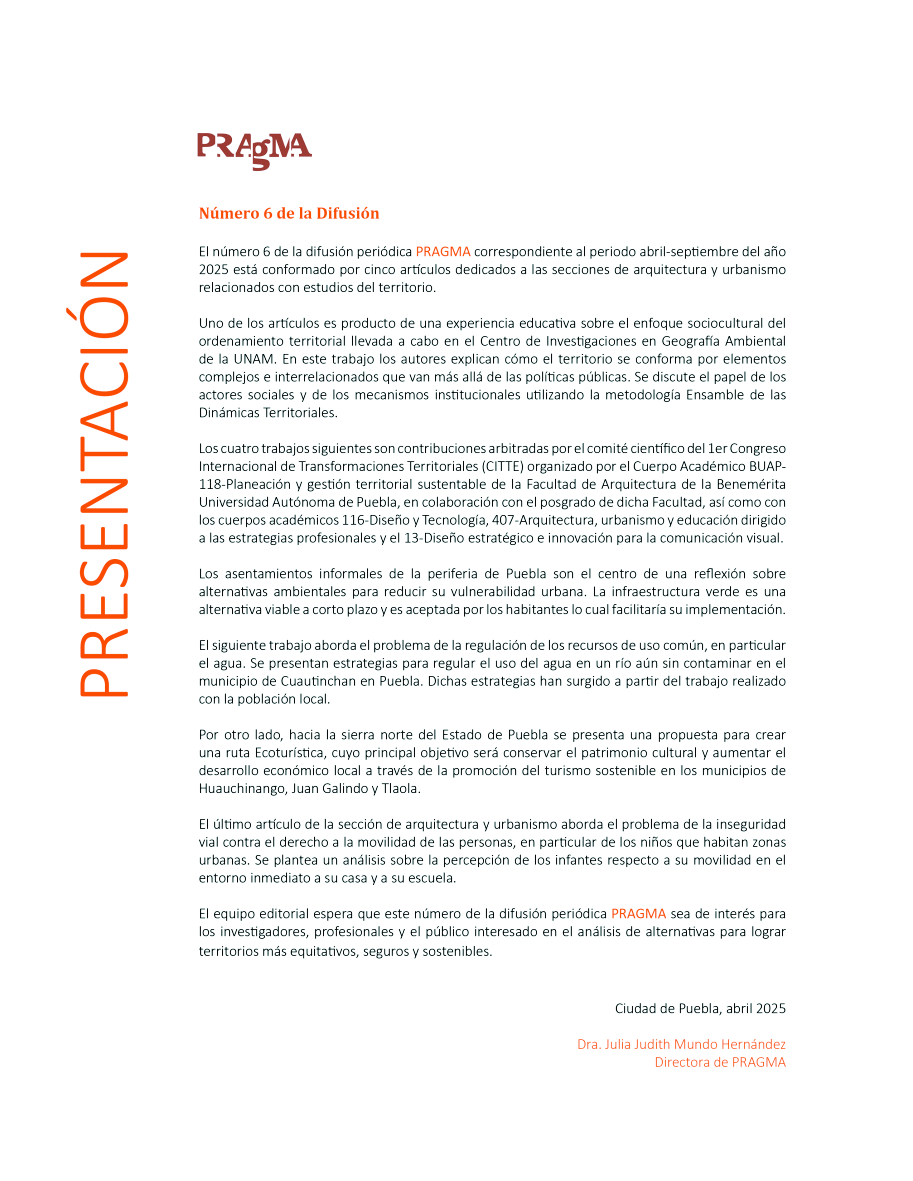
Published 2025-04-05
Keywords
- Presentation PRAGMA
How to Cite

This work is licensed under a Creative Commons Attribution-NonCommercial-NoDerivatives 4.0 International License.
Abstract
Issue 6 of the PRAGMA periodical, corresponding to the April-September 2025 period, consists of six articles: one dedicated to the visual communication section, and five articles dedicated to the architecture and urban planning sections related to territorial studies.
One of the articles is the result of an educational experience on the sociocultural approach to territorial planning carried out at the Center for Research in Environmental Geography at UNAM. This study shows that the territory is made up of complex and interrelated elements that go beyond public policies. The role of social actors and institutional mechanisms is discussed using the Territorial Dynamics Ensemble methodology.
The following four papers are contributions refereed by the scientific committee of the 1st International Congress on Territorial Transformations (CITTE), organized by the BUAP-118 Academic Body - Sustainable Territorial Planning and Management of the Faculty of Architecture of the Benemérita Universidad Autónoma de Puebla, in collaboration with the Faculty's graduate program, as well as the 116 Academic Body - Design and Technology, 407 Academic Body - Architecture, Urbanism, and Education Aimed at Professional Strategies, and 13 Academic Body - Strategic Design and Innovation for Visual Communication.
Informal settlements on the outskirts of Puebla are the focus of a reflection on environmental alternatives to reduce their urban vulnerability. Green infrastructure is a viable short-term alternative and is accepted by residents, which would facilitate its implementation.
The following paper addresses the problem of regulating common-pool resources, particularly water. Strategies are presented for regulating water use in a still unpolluted river in the municipality of Cuautinchan, Puebla. These strategies have emerged from work conducted with the local population.
On the other hand, in the northern mountains of the State of Puebla, a proposal is presented to create an ecotourism route. The main objective of this route is to preserve cultural heritage and increase local economic development through the promotion of sustainable tourism in the municipalities of Huauchinango, Juan Galindo, and Tlaola.
The final article in the architecture and urban planning section addresses the problem of road safety, which hinders people's right to mobility, particularly children living in urban areas. It analyzes children's perceptions of their mobility in the immediate surroundings of their homes and schools.
Finally, the document from the visual communication section contributes to the training of graphic designers. A survey conducted among students at the College of Graphic Design at the Benemérita Universidad Autónoma de Puebla reveals the degree of influence that educational technology has on the development of skills related to the graduate profile of a graphic designer.
The editorial team hopes this issue of the PRAGMA periodical will be of interest to researchers, practitioners, and the public interested in analyzing alternatives for achieving more equitable, safe, and sustainable territories. At the same time, it presents two innovative proposals for teaching urban and graphic design at the undergraduate level that respond to the graduate profile of the programs, as well as to current environmental and educational issues.
City of Puebla, april 2025
Dr. Julia Judith Mundo Hernández
Director of PRAGMA

